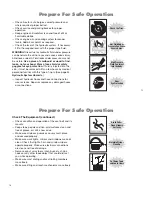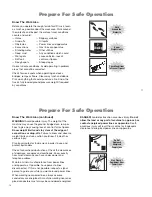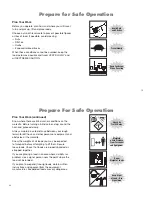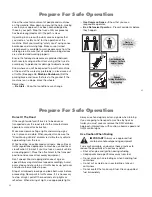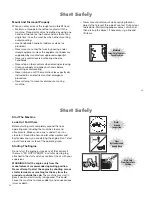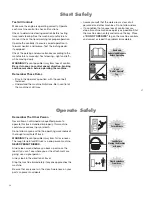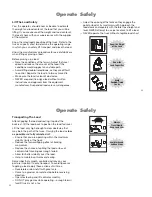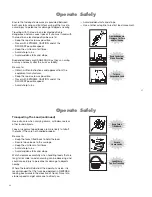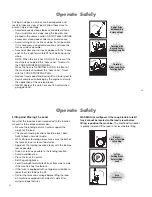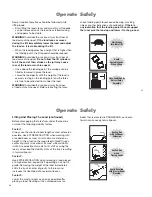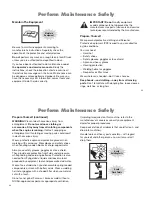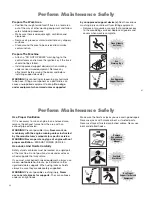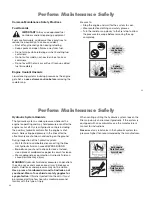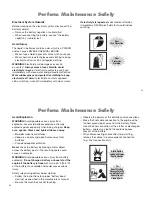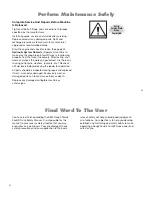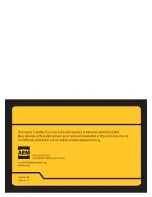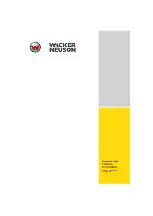
43
Perform Maintenance Safely
Common Maintenance Safety Practices
Fuel Hazards
IMPORTANT!
Always use approved fuel
containers and/or dispensing equipment.
Fuels are fl ammable, so observe these practices to
reduce the possibility of a serious accident.
— Shut off engine and ignition during refueling.
— Keep sparks and open fl ames away from fuel.
— Do not smoke while refueling or when handling fuel
containers.
— Do not cut or weld on or near fuel lines, tanks or
containers.
— Do not overfi ll the tank or spill fuel. Clean up spilled
fuel immediately.
Engine Coolant Hazards
Liquid cooling systems build up pressure as the engine
gets hot, so
use extreme caution before
removing the
radiator cap.
Be sure to:
— Stop the engine and wait for the system to cool.
— Wear protective clothing and safety glasses.
— Turn the radiator cap slowly to the fi rst stop to allow
the pressure to escape before removing the cap
completely.
Remove
Radiator Cap
Slowly
No Smoking
and No Open
Flames
44
Perform Maintenance Safely
Hydraulic System Hazards
The hydraulic system is under pressure whenever the
engine is operating and may hold pressure even after the
engine is shut off. Cycle all hydraulic controls including
the auxiliary hydraulic control after the engine is shut
down. Relieve trapped pressure in the lines after the
attachments are shut down and resting on the ground.
During inspection of the hydraulic system:
— Wait for fl uid to cool before disconnecting the lines.
Hot hydraulic fl uid can cause SEVERE BURNS.
—
Do not
use your hand to check for leaks. Instead,
use a piece of cardboard or paper to search for leaks.
— Wear appropriate eye protection. Hydraulic fl uid can
cause permanent eye injury.
WARNING!
Hydraulic fl uid under pressure can penetrate
the skin or eyes and cause serious injury, blindness or
death. Fluid leaks under pressure may not be visible.
Use a piece of cardboard or wood to fi nd leaks, not
your hand. Wear a face shield or safety goggles for
eye protection.
If fl uid is injected into the skin, it must
be removed within a few hours by medical personnel
familiar with this type of injury.
When venting or fi lling the hydraulic system, loosen the
fi ller cap slowly and remove it gradually. If the system is
equipped with an accumulator, see the manufacturer’s
manual for instructions.
Never
reset any relief valve in the hydraulic system to a
pressure higher than recommended by the manufacturer.
Hot Hydraulic
Fluid Can Cause
Severe Burns
High Pressure
Fluid Can Inject
Into the Body
Summary of Contents for 418-12
Page 59: ...BA 418 12 1 0 418_12_3_Einleitung fm 3 27 Introduction 3 Right side of machine Fig 4 30 20 ...
Page 60: ...3 28 BA 418 12 1 0 418_12_3_Einleitung fm 3 Introduction Front of machine Fig 5 ...
Page 61: ...BA 418 12 1 0 418_12_3_Einleitung fm 3 29 Introduction 3 Rear of machine Fig 6 30 20 ...
Page 63: ...BA 418 12 1 0 418_12_3_Einleitung fm 3 31 Introduction 3 Outside right of the vehicle Fig 8 ...
Page 64: ...3 32 BA 418 12 1 0 418_12_3_Einleitung fm 3 Introduction Inside the cabin Fig 9 ...
Page 65: ...BA 418 12 1 0 418_12_3_Einleitung fm 3 33 Introduction 3 Engine compartment interior Fig 10 ...
Page 66: ...3 34 BA 418 12 1 0 418_12_3_Einleitung fm 3 Introduction Outside front of the vehicle Fig 11 ...
Page 67: ...BA 418 12 1 0 418_12_3_Einleitung fm 3 35 Introduction 3 Outside rear of the vehicle Fig 12 ...
Page 326: ...5 170 BA 418 12 1 0 418_12_5_Bedienung fm 5 Operation ...
Page 338: ...6 12 BA 418 12 1 0 418_12_6_Transport fm 6 Transport ...
Page 426: ...7 88 BA 418 12 1 0 418_12_7_Wartung fm 7 Maintenance ...
Page 462: ...8 36 BA 418 12 1 0 418_12_8_Betriebsstoerung fm 8 Malfunctions Notes ...
Page 499: ...BA 418 12 1 0 BA_418_12_V1_usSIX fm S 7 Index ...
Page 500: ...S 8 BA 418 12 1 0 BA_418_12_V1_usSIX fm Index ...
Page 527: ...FORM RTF 0907 Printed in U S A ...

